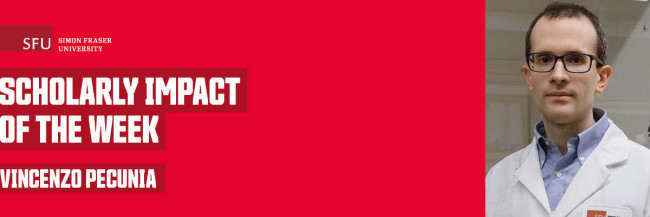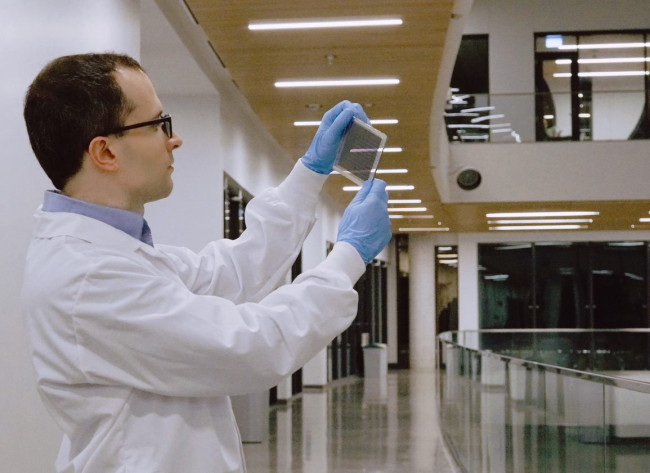
Harvesting the ambient energy created by humans and natural processes is beneficial for the environment, and aids in meeting net-zero greenhouse gas reduction targets. Capturing and converting ambient energy from light, heat and radiowaves—like those from Wi-Fi and cell phones—into electricity has huge potential to power the future.
Simon Fraser University (SFU) professor of sustainable energy engineering (SEE) Vincenzo Pecunia is developing materials that convert ambient and waste energy into electricity. His multidisciplinary Sustainable Optoelectronics Research Group conducts research at the intersection of electronics engineering, materials science and physics. They study the properties of environmentally friendly, printable materials—like organic semiconductors—used in a variety of electronic and smart devices. They also investigate the application of these materials to create the next generation of solar cells and electronics.

SFU sustainable energy engineering professor Vincenzo Pecunia is developing energy harvesting devices, like this solar cell, based on environmentally friendly materials to convert ambient and waste energy into electricity
Pecunia recently led a team of 116 internationally recognized scientists to create a comprehensive database or “roadmap” to guide global efforts to convert ambient energy into clean power. The Roadmap on Energy Harvesting Materials was published in the Journal of Physics Materials.
The roadmap recognizes several factors in the pursuit of green and sustainable energy. The global scientific effort is rapidly growing. The push to make environments and activities as efficient as possible—through smart cities, smart homes and precision agriculture, for example, is also rising.
This is the first time a worldwide network of energy harvesting experts have worked together to build a comprehensive inventory of these technologies and chart a course for their advancement.

Five major approaches to energy harvesting include photovoltaics (light/solar); triboelectrics (for example, creating electricity from vibrations or friction); piezoelectrics (materials that create electricity under stress); radiofrequency energy harvesting; and thermoelectrics (materials that convert heat into electricity).
We spoke with professor Pecunia about his research.
How did you manage to bring together over 100 scientists to collaborate on the roadmap?
Throughout my research career, I have worked in various positions in Europe, Asia, and North America, which has allowed me to establish a vast network of leading experts in photovoltaics and other energy harvesting technologies. When I reached out to some of these contacts about the roadmap project, they were enthusiastic to join in. However, to ensure that the roadmap was comprehensive and covered all relevant research areas, I also expanded my search beyond my professional network through an extensive literature review and by seeking referrals from colleagues involved in the roadmap.
What inspired you to take on this project?
I conceived the “Roadmap on Energy Harvesting Materials” motivated by the potential of energy harvesting materials to meet the demand for clean energy.
From a research standpoint, I thought that launching this roadmap would help overcome sectorial divides and foster the cross-pollination of various energy harvesting technologies. Indeed, I firmly believe that the synergistic integration of diverse energy harvesting technologies is key to advancing our ability to generate clean energy. Moreover, by enlisting world-leading experts to provide a forward-looking perspective on the field, I wanted the roadmap to offer guidance to researchers on promising directions that could take us to the next generation of energy harvesters.
Finally, as an educator, I saw the roadmap as an opportunity to inspire younger generations to become involved in the field and work towards the vision of clean energy anytime, anywhere.
What are some of the energy harvesting technologies listed in the roadmap? Any exciting new areas of potential?
The roadmap covers all major approaches to harvesting ambient energy, including light, mechanical action (such as vibrations), heat, and radiowaves (such as those used by cell phones and Wi-Fi). For each approach, the roadmap explores the potential of various materials being researched for more efficient energy conversion. A particular highlight is indoor light harvesting, an area that my group is also actively developing. Recent advances have resulted in conversion efficiencies of ambient indoor light into electricity of up to 40 percent, with potential for even higher efficiencies of up to 60 percent. This is a significant development, as ambient light is widely available and can provide high energy output per unit area. Therefore, this technology paves the way for the use of ambient light to power a broad range of applications.
Can you provide examples of devices that use optoelectronics? What is the Sustainable Optoelectronics Research Group currently working on with this technology?
Optoelectronics is a field that encompasses a wide range of devices based on semiconductors, such as solar cells, light-emitting diodes (LED displays), and various sensors for healthcare, smart homes, and smart manufacturing. Optoelectronics can be found in many aspects of our lives, from our homes to our workplaces and beyond. At my research group, we are dedicated to sustainable optoelectronics research. Our focus is on developing solar cells and sensors with high sustainability profiles compared to conventional optoelectronics. We achieve this by using semiconductors that can be printed, which reduces material and energy consumption as well as costs associated with optoelectronics manufacturing. This approach is essential to advancing the use of solar cells and optoelectronics in our daily lives, promoting environmental sustainability, and improving our overall quality of life.
How can interested students and researchers learn more about the roadmap, energy harvesting, optoelectronics and this field of research?
The "Roadmap on Energy Harvesting Materials" will be a primary learning resource for the course “SEE 475 - Energy Harvesting Materials,” which I am launching this summer as part of SFU's Sustainable Energy Engineering program. This course will provide SFU students with the opportunity to learn how to design energy harvesting materials and devices to efficiently convert ambient energy into electricity. Key highlights will include guest seminars given by industry experts and state-of-the-art laboratories where students will learn how to design and fabricate solar cells from scratch.
I will also be hosting a webinar on energy harvesting materials later this year with the involvement of a number of world-leading experts with whom I co-authored the roadmap. This will be an exciting opportunity for the SFU community and beyond to be inspired by the capabilities and potential of energy harvesting technologies to have a meaningful impact on our daily lives. I hope to see many of you there!
For more, visit the Sustainable Optoelectronics Research Group and check out the SFU News story: Global experts propose a path forward in generating clean power from waste energy.
SFU's Scholarly Impact of the Week series does not reflect the opinions or viewpoints of the university, but those of the scholars. The timing of articles in the series is chosen weeks or months in advance, based on a published set of criteria. Any correspondence with university or world events at the time of publication is purely coincidental.
For more information, please see SFU's Code of Faculty Ethics and Responsibilities and the statement on academic freedom.